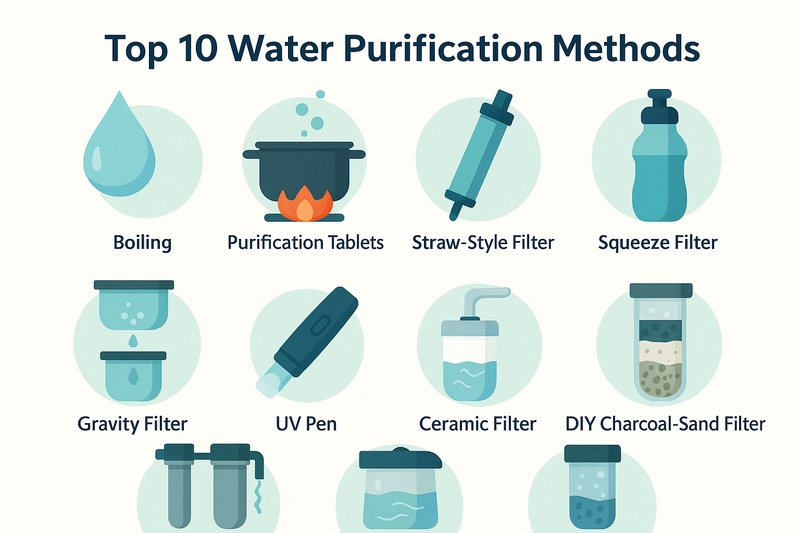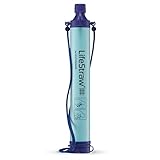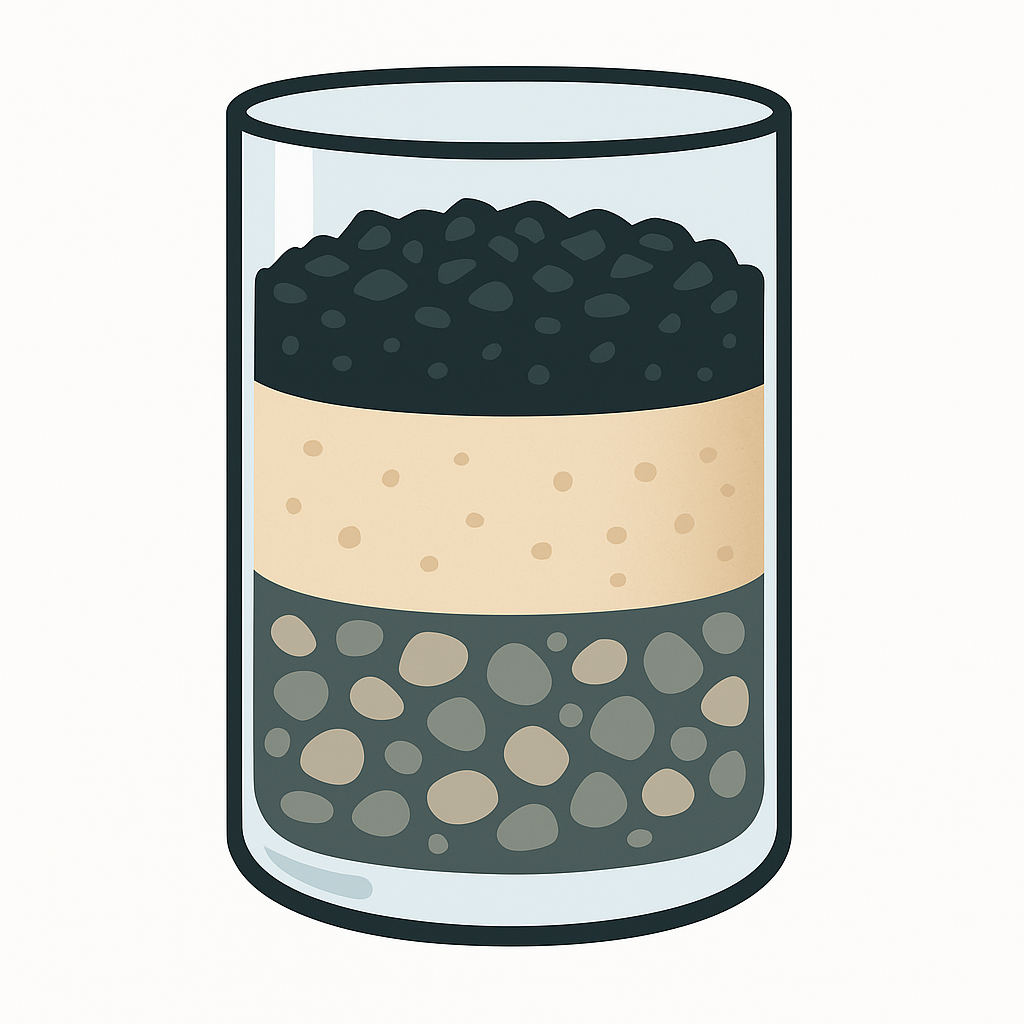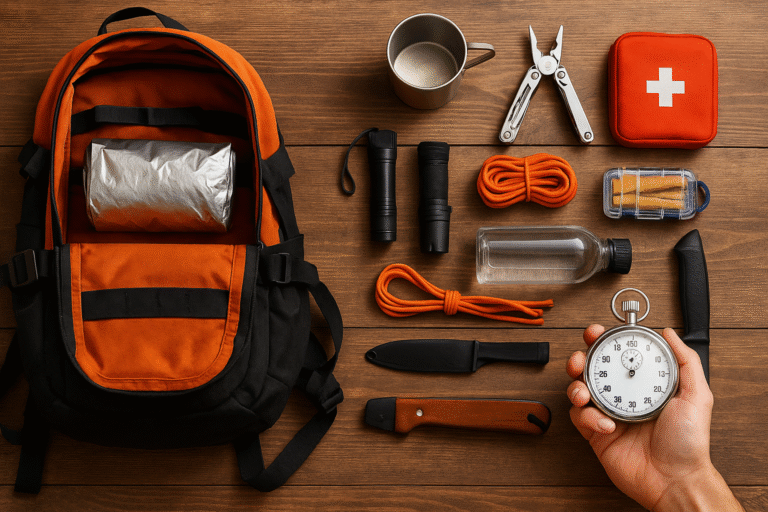Top 10 Water Purification Methods Reviewed
If you’re out in the wilderness, riding out a natural disaster, or dealing with a grid-down emergency, one resource becomes more important than food, fire, or even shelter: clean drinking water. The human body can survive weeks without food — but only about 3 days without water. And if the water you find is contaminated, drinking it can be just as dangerous as going without.
This post contains affiliate links. I may earn a small commission at no extra cost to you. Learn more.
Untreated water often carries bacteria, viruses, protozoa, parasites, and sediment. In survival situations, these can trigger life-threatening illnesses like dysentery or giardia, crippling you when you can least afford to be weak. That’s why every serious prepper, camper, or backcountry traveler needs to know multiple ways to purify water — and have the right gear to back it up.
In this guide, we’ll break down the top 10 water purification methods. For each one, you’ll see:
-
🔍 How it works (simple breakdown you can apply in the field)
-
✅ Pros & cons (so you know the strengths and limitations)
-
🎒 Recommended gear (battle-tested equipment you can trust)
By the end, you’ll know exactly which method is best for everyday prepping, ultralight adventures, basecamp setups, or last-resort survival — and you’ll never be caught unprepared when safe water matters most.
💧 Pro Tip: Also check out our Ultimate Water Purification Guide for an even deeper dive into staying hydrated in survival situations.
Quick Gear Picks
-
✅ Best Ultralight: LifeStraw Personal Water Filter
-
✅ Best Family/Group Use: ProOne Big Gravity Filter
-
✅ Best Basecamp/Home: APEC RO System
1.🔥 Boiling: The Oldest & Most Reliable Method
Boiling has been used for centuries because it works. When you bring water to a rolling boil for at least 1 minute (or 3 minutes above 6,500 ft), you’ll kill nearly every dangerous microbe — bacteria, viruses, and parasites — without needing filters or chemicals.
Pros:
✅ Nearly 100% pathogen kill rate
✅ No chemicals, no special gear required
✅ Works anywhere you can make fire or heat water
Cons:
⚠️ Requires fuel, fire, or stove
⚠️ Takes time to heat and cool
⚠️ Doesn’t remove chemicals, heavy metals, or sediment
Recommended Gear:
2. 💊 Purification Tablets: Lightweight & Chemical Defense
Purification tablets (iodine or chlorine dioxide) work by triggering a chemical reaction that destroys harmful microbes in your water. Just drop a tablet into your container, wait 30–60 minutes, and you’ll have water that’s safer to drink in the field.
Pros:
✅ Ultra-lightweight and compact — fits in any pack
✅ Simple to use — no moving parts or setup
✅ Excellent backup option for emergencies
Cons:
⚠️ Leaves a chemical taste and odor
⚠️ Takes 30–60 minutes to work
⚠️ Less effective against certain protozoa (like Cryptosporidium)
No fire or stove? Learn how to purify water without boiling using field-friendly methods.
Recommended Gear:
3.🥤 Straw-Style Filters: Sip Straight from the Source
Personal straw filters like the LifeStraw let you drink water directly from a stream, pond, or bottle without complicated setups. Inside, a fine microporous membrane traps bacteria, protozoa, and even microplastics — giving you instant access to safer water in the field.
Pros:
✅ Ultralight and pocket-sized
✅ No pumping or setup — just sip and go
✅ Instant use, great for emergencies
Cons:
⚠️ Doesn’t remove viruses
⚠️ Limited lifespan (~1,000 liters per straw)
⚠️ Only works while you’re drinking — not ideal for storing water
Recommended Gear:
4. 💧 Squeeze Filters: Compact & Efficient
Squeeze filters, like the Sawyer MINI, are one of the most popular backpacking and survival options. You simply fill the included pouch (or any compatible water bag) with untreated water, attach the filter, and squeeze clean water directly into your bottle or hydration pack. Lightweight, simple, and highly effective for most outdoor water sources.
Pros:
✅ Lightweight and pack-friendly
✅ Removes bacteria, protozoa, and microplastics
✅ Can filter thousands of liters before replacement
✅ Works with standard bottles and hydration packs
Cons:
⚠️ Slower flow rate compared to pumps
⚠️ Doesn’t remove viruses
⚠️ Pouches can wear out over time
Recommended Gear:
5. Gravity Filter
Gravity filters are a staple in both everyday kitchens and emergency setups. The ProOne Big+ Gravity Water Filter System sits on your counter (or in your RV, cabin, or camp) and uses the simplest force in the world — gravity — to push water through its high-performance filters. Just pour in tap water, well water, or collected rainwater into the top chamber, and let gravity do the heavy lifting. In a few hours, you’ve got gallons of clean, great-tasting water ready to drink.
Unlike disposable pitchers or cheap faucet attachments, this stainless-steel unit is built to last. It’s IAPMO-certified to reduce heavy metals like lead, cut out “forever chemicals” (PFAS), microplastics, chlorine taste, and other contaminants that creep into modern water supplies. Better yet, it keeps the good minerals (like calcium) that your body actually needs.
Pros:
✅ 3-gallon capacity — great for families, camps, or off-grid setups
✅ Removes lead, PFAS, microplastics, chlorine taste & odor
✅ Durable stainless steel — corrosion-resistant, looks sharp on your counter
✅ Portable — perfect for homes, RVs, or survival retreats
✅ Long-lasting silver-infused filter (up to 9 months per element)
✅ Works without power — totally gravity-driven
Cons:
⚠️ Takes up counter space — not ultralight or compact
⚠️ Slower flow rate compared to pump or squeeze filters
Recommended Gear:
6. 🔦 UV Pens: High-Tech Water Purification
UV pens like the SteriPEN Adventurer Opti use powerful UV-C light to scramble the DNA of harmful microbes, making them unable to reproduce or cause illness. Just stir the pen in your bottle for 60–90 seconds, and you’ll have safe drinking water without chemicals or filters. It’s one of the fastest and most effective purification methods when used correctly.
Pros:
✅ Kills bacteria, protozoa, and even viruses
✅ Works in as little as 1–2 minutes
✅ No chemical taste or added parts
✅ Lightweight and portable
Cons:
⚠️ Requires batteries (or charging)
⚠️ Only works in clear water (sediment must be filtered first)
⚠️ More fragile than traditional methods
Recommended Gear:
7.🏺 Ceramic Filters: Durable & Reliable
Ceramic filters work by forcing water through tiny pores in a ceramic element, physically trapping microbes and sediment. They’re often used in countertop systems or as field cartridges for backpacking filters. While slower than other options, they’re highly durable and can be scrubbed clean to restore flow, making them a long-lasting choice for repeated use.
Pros:
✅ Long-lasting and durable — can be cleaned and reused
✅ Effective against bacteria, protozoa, and sediment
✅ Good for long-term or repeated use
✅ Reliable even in remote areas
Cons:
⚠️ Slower flow rate than hollow-fiber filters
⚠️ Doesn’t remove viruses
⚠️ Fragile if dropped or frozen
Recommended Gear:
8.💧 Reverse Osmosis: Complete Purification Power
Reverse osmosis (RO) systems use a semipermeable membrane to strip water of nearly all contaminants — from heavy metals and chemicals to bacteria and other microbes. They’re widely used in homes, RVs, and basecamps where dependable, clean water is needed every day. While slower and more resource-intensive than other methods, RO is one of the most thorough purification options available.
Pros:
✅ Removes chemicals, heavy metals, bacteria, protozoa, and even some viruses
✅ Produces some of the cleanest, safest water possible
✅ Excellent for long-term home or basecamp use
✅ Great for families or anyone with compromised water supplies
Cons:
⚠️ Requires electricity or strong water pressure
⚠️ Slower process compared to filters or boiling
⚠️ Produces wastewater as part of the process
Recommended Gear:
9.♨️ Distillation: Ultimate Impurity Removal
Distillation works by boiling water into steam and then condensing it back into liquid form. This process leaves behind salts, heavy metals, chemicals, and microbes, producing some of the purest water possible. It’s especially valuable in situations involving chemical contamination or saltwater, where filters and tablets can’t help. While highly effective, distillation is also one of the slowest and most fuel-intensive purification methods.
Pros:
✅ Removes bacteria, viruses, protozoa, and other microbes
✅ Strips out salts, heavy metals, and most chemicals
✅ Works even in cases of chemical spills or brackish/saltwater
✅ Produces some of the purest water possible
Cons:
⚠️ Very slow compared to other methods
⚠️ Requires large amounts of fuel or electricity
⚠️ Equipment can be bulky and less portable
Recommended Gear:
10.🪵 DIY Charcoal & Sand Filter: Last-Resort Survival Hack
When all else fails and you don’t have access to modern filters or tablets, you can improvise a charcoal and sand filter. By layering gravel, sand, and crushed charcoal inside a container (like a cut plastic bottle or hollowed log), water can be passed through to remove sediment, dirt, and some microbes. It won’t make water perfectly safe, but it can buy you time in a survival situation until better purification is available.
Pros:
✅ No specialized gear required
✅ Uses natural or scavenged materials
✅ Reduces turbidity (cloudiness) and improves taste
✅ A practical teaching skill for bushcraft and survival
Cons:
⚠️ Does not reliably remove viruses
⚠️ Much slower than modern filters
⚠️ Effectiveness depends on clean materials and proper construction
| Method | Removes Pathogens | Removes Chemicals | Speed | Best For |
|---|---|---|---|---|
| Boiling | ✅ Yes | ❌ No | ⏱ Slow | Emergency/bug-out |
| Tablets | ✅ Yes | ❌ Limited | ⏱ Slow | Ultralight backup |
| Straw Filter | ✅ Yes | ❌ No | ⚡ Instant | Solo hikers |
| Squeeze Filter | ✅ Yes | ❌ No | ⏱ Moderate | Backpacking |
| Gravity Filter | ✅ Yes | ❌ No | ⏱ Moderate | Families, groups |
| UV Light | ✅ Yes | ❌ No | ⚡ Fast | Camps, clear water |
| Ceramic Filter | ✅ Yes | ❌ No | ⏱ Slow | Basecamp |
| Reverse Osmosis | ✅ Yes | ✅ Yes | ⏱ Slow | Home, basecamp |
| Distillation | ✅ Yes | ✅ Yes | ⏱ Very slow | Chemical spills |
| DIY Sand/Charcoal | ⚠️ Limited | ❌ No | ⏱ Very slow | Last resort |
FAQs
What’s the fastest way to purify water outdoors?
UV pens and boiling are fastest — both neutralize microbes within minutes.
Which method removes chemicals or heavy metals?
Reverse osmosis and distillation are the most effective.
What’s the best budget method for a bug-out bag?
Straw filters like the LifeStraw are ultralight and affordable.
🧭 Final Thoughts on Water Purification
No matter where you are — deep in the wilderness, hunkered down during a blackout, or facing a natural disaster — clean water is non-negotiable. Each purification method has its strengths and weaknesses: some excel at killing pathogens, others remove chemicals, and a few (like reverse osmosis or distillation) go nearly all the way. That’s why seasoned preppers and survivalists never rely on just one option.
The best approach is layered preparedness:
-
Keep a primary system (gravity filter, RO unit, or distiller) for daily or basecamp use.
-
Carry a field-ready method (straw filter, squeeze filter, or tablets) for portability.
-
Always know last-resort techniques (boiling, DIY charcoal filter) in case your gear fails.
In survival, redundancy is security. If you’ve got multiple ways to make dirty water safe, you’re already ahead of the game.
Bottom line: Water is life. Plan, prepare, and always have a backup.
👉 Further Reading:
- Long-Term Water Storage: Complete Prepper Guide – Store water safely for months or years.
- How to Purify Water with Natural Methods – Primitive and low-tech ways to make water safe.
Don’t gamble on dirty water — pack the right method now, before you need it.

















